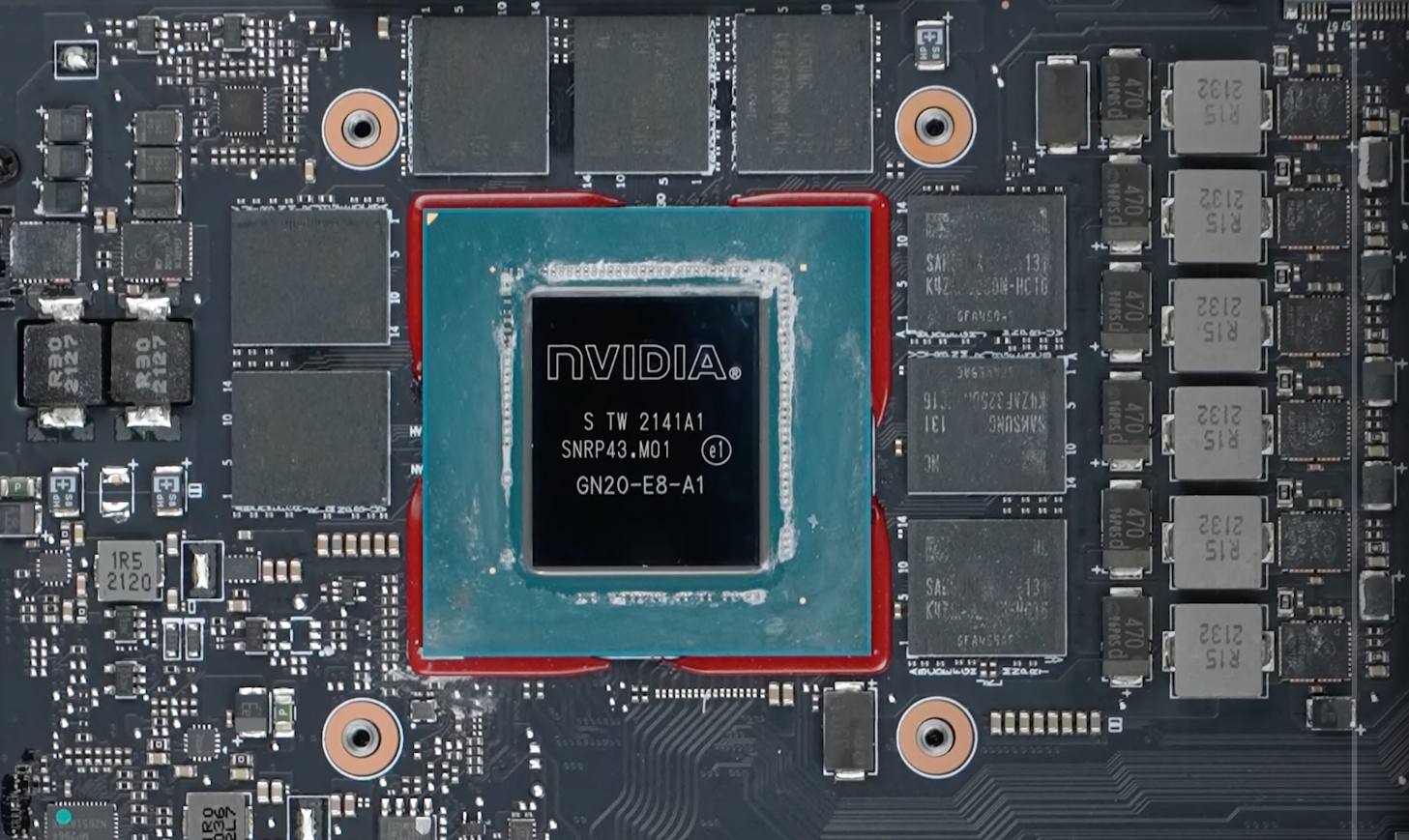Nvidia's Mysterious GA103 GPU Pictured
Could the new mobile 3080 Ti chip eventually find its way to desktop GPUs?
It turns out that Nvidia's recently introduced GeForce RTX 3080 Ti graphics processor for laptops (which we tested in MSI's GE76 Raider earlier this week) doesn't use severely cut-down GA102 silicon. Instead, it relies on a rather mysterious GA103 die. A Chinese video blogger snapped a pic of the new GPU this week, revealing that this is a brand-new piece of silicon with a 496 mm^2 die size designed with high-end gaming laptops in mind. But it could also make a lot of sense for desktops.
Following the launch of the mobile GeForce RTX 3080 Ti this week, Chinese video blogger Geekerwan (via VideoCardz) opened up a laptop featuring the GPU and revealed the GA103 graphics processor, labeled as GN20-E8-A1.
Geekerwan's measurements indicate that GA103's die size is 496 mm^2, putting it right between the lower-end GA104 (392 mm^2) and the higher-end GA102 (628 mm^2). Earlier rumors indicated that the GA103 GPU features as many as 7680 CUDA cores and a 320-bit memory interface. But in the case of the laptop GPU, Nvidia cut the GPU down to 7424 CUDA cores, 96 texture units, 58 render backends, and a 256-bit memory interface.

Given the ongoing GPU supply and pricing issues, a natural question is whether the company intends to use GA103 for desktop PCs. If Nvidia decides to fill the gap between the GeForce RTX 3070 Ti (6144 CUDA cores, 256-bit memory interface) and the GeForce RTX 3080 (8704 CUDA cores, 320-bit memory interface), the GA103 may be just what the doctor ordered, with its up to 7680 CUDA cores and a 320-bit memory bus. In fact, even cut-down variants of the GA103 make sense for desktops and could compete with the best graphics cards around.
Nvidia GPU Comparisons
| Row 0 - Cell 0 | GA102 | GA103 | GA104 |
| CUDA Cores | 10,752 | 7,680 | 6,144 |
| Memory Interface | 384-bit | 320-bit | 256-bit |
| Transistor Count | 28.3 billion | ? | 17.4 billion |
| Die Size | 628 mm^2 | 496 mm^2 | 392 mm^2 |
| Node | Samsung 8N | Samsung 8N | Samsung 8N |
We have no idea which configurations of GA103 GPUs will be available and where they will land (desktop or laptop). But since Nvidia frequently disables about 20% of its GPU's functional units (and up to 40% semi-officially) when it needs to sell partially faulty processors, there is a very fertile field for speculation here.
When Nvidia introduced the high-end RTX 30-series 'Ampere' lineup in mid-2020, one thing that stuck out was the huge gap between the GA102 processor (up to 84 SMs and 384-bit interface) and the GA104 GPU (up to 48 SMs and a 256-bit interface). Given the supply shortages for GPUs, filling that gap with a smaller GPU that still meets the needs of cards like the desktop 3080 could mean more cards to go around.
While Nvidia has a lot of freedom with configurations of its GPUs, the GA102 was still too complex and seemingly too hot for a laptop, even when severely cut down. There were rumors about the GA103 GPU at the time, but since Nvidia never confirmed the chip, it was forgotten—until this week.
That gives Nvidia a lot of flexibility with Ampere GPUs. The 3090, 3080 Ti, 3080 12GB, and the upcoming 3090 Ti all need the largest GA102 chip, due to using its 384-bit interface. Currently, the mobile 3080 Ti is the only model using GA103, but it would make sense to also use that chip for the 3080 10GB and potentially the 3070 Ti as well. GA104 is the most ubiquitous of the chips right now, finding use in the 3070 Ti, 3070, 3060 Ti, and 3060 on the desktop size, as well as the 3080, 3070, and 3060 laptop models. Then there's the GA106 for the 3060 and 3050 desktop cards and mobile 3060, and finally the GA107 is currently only used in the mobile 3050 Ti and 3050.
That's five different GPUs spread out over fourteen GeForce products, never mind the various professional Nvidia cards and the GA100 data center chips. Of course, balancing wafer production across all those designs is something else Nvidia has to consider, but it's basically the only company using Samsung Foundry's 8N node. We can only hope that supply will catch up to demand, sooner than later.
Get Tom's Hardware's best news and in-depth reviews, straight to your inbox.

Anton Shilov is a contributing writer at Tom’s Hardware. Over the past couple of decades, he has covered everything from CPUs and GPUs to supercomputers and from modern process technologies and latest fab tools to high-tech industry trends.